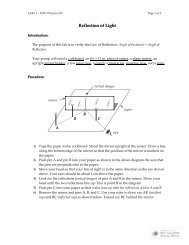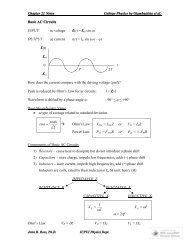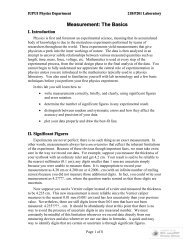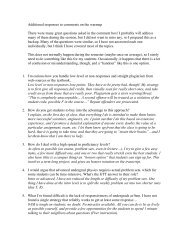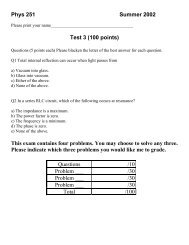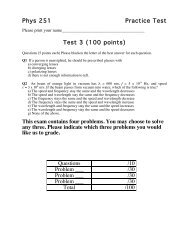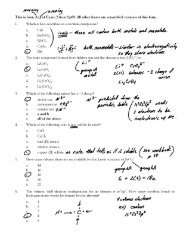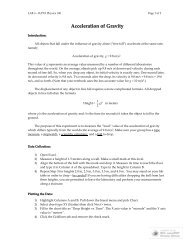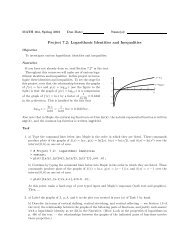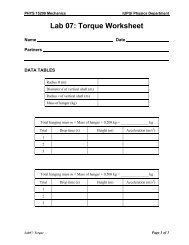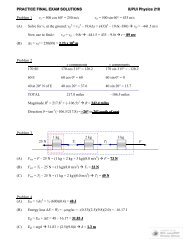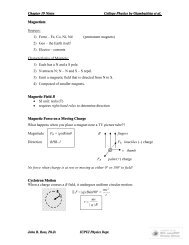Workshop Slides - Web Physics
Workshop Slides - Web Physics
Workshop Slides - Web Physics
You also want an ePaper? Increase the reach of your titles
YUMPU automatically turns print PDFs into web optimized ePapers that Google loves.
Implementing<br />
Just-in-Time Teaching:<br />
The What, How, and When<br />
of JiTT
Outline<br />
Using WarmUps - The Interactive Lecture<br />
Developing Questions<br />
Grading Options<br />
Assessment - How can this improve<br />
Time Commitment<br />
Technology Options
Review of JiTT<br />
World Wide <strong>Web</strong><br />
Homework<br />
Student<br />
Classroom<br />
Assignment<br />
design
Everything else is an option
WarmUp Exercises (one option)<br />
Due 2 hours before class<br />
Cover that day’s s material<br />
3 (somewhat ambiguous) short essay questions<br />
An online, pre-class reading quiz<br />
Students better prepared for class<br />
Faculty better prepared for students<br />
Class is student-centered and interactive
Question:<br />
What do you already do that accomplishes<br />
some or all of the same things
The “Interactive Lecture” (option)<br />
Step 1: Synchronization<br />
Read the students’ responses…<br />
What do they understand<br />
Step 2: Preparation<br />
Select excerpts from students work<br />
Step 3: Execution<br />
Class is a dialog based on student<br />
excerpts and faculty notes
Example WarmUp<br />
WarmUp: Is it possible to add heat to an ideal gas<br />
without changing its temperature If it is possible,<br />
please explain how it is done.<br />
“It is not possible because the internal energy of an ideal gas only<br />
depends on the temperature.... the internal energy will increase when<br />
the temperature rises.…”<br />
“It is possible to add heat to an ideal gas without it changing it's<br />
temperature by the gas recieving the heat, and the atoms of that gas<br />
getting excited enough to disperse that heat as fast as they recieve<br />
it…”<br />
“If you add heat to a system while the system is doing the<br />
corresponding amount of work, the temperature will not change.”
Choosing and using student responses<br />
Use a mix of “good” and “bad” responses<br />
Always say something positive (see last example)<br />
This is true, but what if something else occurs simultaneously…<br />
This makes sense, but something is missing…<br />
This is a great response… how would we know how much heat<br />
to add<br />
More useful phrases…<br />
This is a good answer, but to a different question…<br />
This has a great beginning, but more could be added…<br />
This is correct, but the reasoning isn’t t quite right…
Creating extensions<br />
Ask students to extend or respond to one<br />
another’s s work<br />
What part of this is completely correct<br />
Under what circumstances would these be<br />
correct<br />
What word or two could be changed to fix this<br />
completely<br />
What is particularly good about this response
Expansion and Comparison<br />
Ask students to expand the scope of the question<br />
Is this true for other cases Which<br />
When is this statement false What happens then<br />
Is this similar to something we have done before What<br />
Ask students to compare “Dueling Answers”<br />
Show two very different answers, not obviously exclusive:<br />
Ask if they are exclusive<br />
Show two obviously exclusive answers:<br />
Ask for a vote on which is correct<br />
Do some analysis<br />
Repeat as needed
Question:<br />
How else could you ask students to engage<br />
with one another’s s answers
JiTT in Chemistry<br />
This picture depicts matter<br />
at the submicroscopic level.<br />
Describe what you see and<br />
take a guess as to what the<br />
identity of the substance is.<br />
“The particles are well spaced out so I would guess the<br />
substance to be a gas. The substance is a gas composed<br />
of 2 elements that are in an equal ratio.”<br />
“After reading Chapter 1 in the book I would guess that<br />
the substance is water in the form of a solid because the<br />
atoms are in order. However, I could be wrong because I<br />
think the atoms in a solid might be closer together.”
Creating questions (options…)<br />
1. Start with “What do you want your<br />
students to learn” Questions should ask<br />
students to engage with the big ideas, not<br />
look up the small facts<br />
2. Try a key phrase. I like<br />
a) What is the difference between… <br />
b) In your opinion, what does ___ mean<br />
c) In your own words, explain…<br />
d) How/why do you think ____ occurs<br />
e) Is ____ possible<br />
f) What do you think happens when…
More options for questions…<br />
Consider “where you are” with a topic<br />
Connect with Bloom’s s taxonomy<br />
How would you explain _____ to a 5th grader<br />
How would you apply (the reading) to the<br />
following situation<br />
How would you break down the following<br />
problem into sub-problems<br />
Create a new example of Y similar to the<br />
example of X in the book<br />
Read (something) and evaluate whether the<br />
author has correctly understood _____
Activity<br />
Write a WarmUp question or two for any<br />
course of your choice on the cards. Indicate<br />
what course this is for.<br />
Pass them forward<br />
Discussion
Grading/evaluation options<br />
How do I assign points<br />
Participation only (does this show a good faith<br />
effort)<br />
Rubric (see handout)<br />
High stakes (No reports…)<br />
I can’t t grade all these before class!!<br />
Spot check for in-class use<br />
Assign points later<br />
Use as springboard for undersatnding students
Assessment example I (N=155)<br />
Q1 Do the WarmUps help you stay caught up<br />
Q2 Do you “Cram” before tests in this course<br />
Q3 Do you “Cram” in your other courses<br />
1- Yes<br />
2- Yes<br />
3- Yes<br />
“A” students<br />
85%<br />
14%<br />
43%<br />
“B” students<br />
89 %<br />
39%<br />
61%<br />
“C” students<br />
89%<br />
47%<br />
68%<br />
“D” students<br />
84%<br />
68%<br />
68%<br />
“F” students<br />
92%<br />
58%<br />
58%
Assessment II: retention<br />
Attrition (DFW)<br />
70%<br />
60%<br />
50%<br />
40%<br />
30%<br />
20%<br />
First Semester Attrition (152)<br />
Attrition (DFW)<br />
70%<br />
60%<br />
50%<br />
40%<br />
30%<br />
20%<br />
Second Semester Attrition (251)<br />
10%<br />
10%<br />
0%<br />
Sp94 F95 Sp97 F98 Sp00 F01 Sp03<br />
Semester<br />
0%<br />
Sp94<br />
Sp95<br />
SP96<br />
Sp97<br />
Sp98<br />
Sp99<br />
Semester<br />
Sp00<br />
Sp01<br />
Sp02<br />
Sp03<br />
60.0<br />
Attrition in Calculus 164<br />
Attrition in Biology N100<br />
Attrition (% DFW)<br />
50.0<br />
40.0<br />
30.0<br />
20.0<br />
10.0<br />
0.0<br />
F98<br />
Sp99<br />
F99<br />
Sp00<br />
F00<br />
Sp01<br />
F01<br />
Semester<br />
Sp02<br />
F02<br />
Sp03<br />
F03<br />
Attrition (% DFW)<br />
35<br />
30<br />
25<br />
20<br />
15<br />
10<br />
5<br />
0<br />
Sp97 F97 Sp98 F98 Sp99 F99 Sp00 F00 Sp01 F01 Sp02 F02 Sp03<br />
Semester
Assessment III (Biology, N=200)<br />
N~200,<br />
4 questions each<br />
category<br />
Questions with no interventions<br />
Questions tied to additional<br />
homework<br />
problems<br />
Questions tied to<br />
WarmUp or cooperative<br />
learning questions<br />
Questions tied to<br />
WarmUp and cooperative<br />
learning questions<br />
% Gain<br />
(Post%-pre%)<br />
%G = 15%<br />
(25%-10%)<br />
%G = 17%<br />
(35%-18%)<br />
%G = 45%<br />
(59%-14%)<br />
%G = 56%<br />
(68%-12%)<br />
Average Normalized<br />
Gain<br />
= 0.167<br />
=0.207<br />
= 0.511<br />
= 0.636
Assessment IV (affective, N=56)<br />
1. Do you feel that the warm-up assignments helped your professor<br />
make good use of the classroom time<br />
2. Do other professors have better ways to determine how class time<br />
should be used<br />
3. Do you feel that the warm-up assignments helped your professor<br />
focus on important topics in class<br />
4. Do your other professors have effective methods for focusing on<br />
important topics in class<br />
5. Did the warm-up assignments help your professor get a good feel<br />
for what the students know<br />
6. Do your other professors have effective methods for getting a feel<br />
for what their students know<br />
7. Do you think the warm-up assignments help your professor get<br />
students involved during the lecture<br />
8. Do your other professors have effective methods for getting their<br />
students involved in lecture<br />
Yes 47<br />
87%<br />
Yes 14<br />
26%<br />
Yes 49<br />
91%<br />
Yes 33<br />
61%<br />
Yes 42<br />
81%<br />
Yes 20<br />
38%<br />
Yes 37<br />
70%<br />
Yes 23<br />
43%<br />
No 7<br />
13%<br />
No 40<br />
74%<br />
No 7<br />
13%<br />
No 21<br />
39%<br />
No 10<br />
19%<br />
No 33<br />
62%<br />
No 16<br />
30%<br />
No 31<br />
57%
Student Comments<br />
<br />
<br />
<br />
<br />
<br />
“This was a fantastic course. It was the hardest course I’veI<br />
taken yet, but also the most fun.”<br />
I think the WarmUps are a good idea because they give<br />
students a chance to think about the material prior to<br />
lecture.<br />
"This course was very well structured. It was obvious that<br />
a lot of time was spent in preparation for it.”<br />
"152 & 251 have made me reach more than any courses I<br />
have taken.”<br />
Don’t t tell anyone, but I think I will greatly miss my<br />
physics class.
How long is this going to take<br />
One time investments<br />
Identifying technology support and<br />
methods:<br />
(depends on IT)<br />
Writing questions:<br />
10-20 hours/course<br />
Ongoing time commitments<br />
Posting the questions: 0.5-1 hour/week<br />
Reviewing them before class<br />
~ 0.5 hour/class<br />
Grading:<br />
30 sec/student-class
When do I begin<br />
This fall, in just one course!<br />
Start in first week. Students develop habits<br />
early on<br />
Stay consistent: do not changes system in<br />
mid semester (without explaining)<br />
2 times/week is best
Other JiTT Components<br />
Weekly Puzzle<br />
Opposite “Bookend” to WarmUp<br />
“What is <strong>Physics</strong> Good For”<br />
Student-Faculty and Student-Student<br />
Communication tools<br />
Collaborative Recitation



